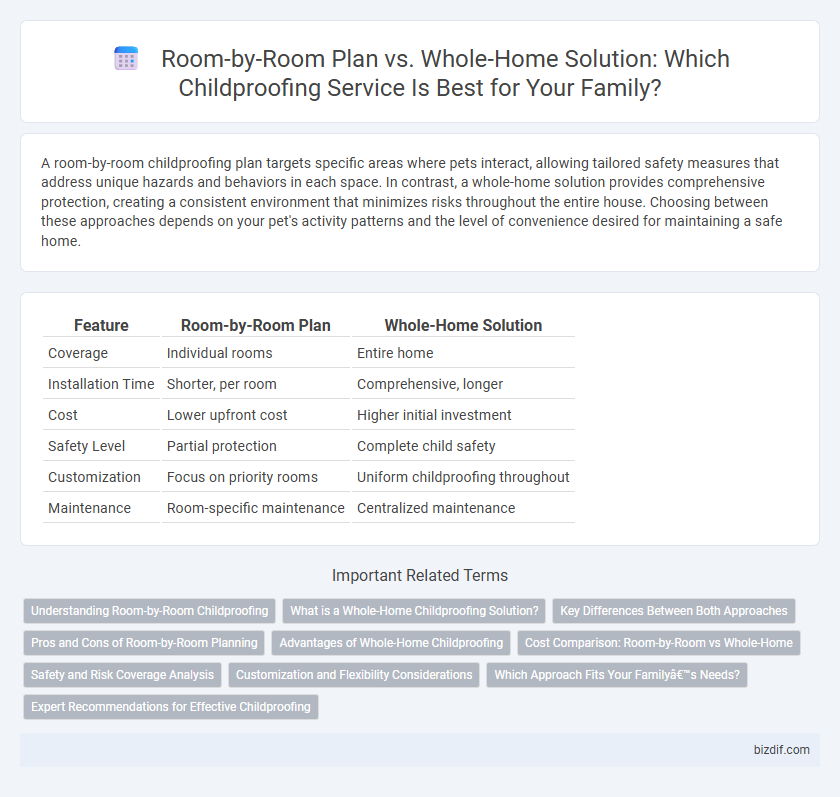A room-by-room childproofing plan targets specific areas where pets interact, allowing tailored safety measures that address unique hazards and behaviors in each space. In contrast, a whole-home solution provides comprehensive protection, creating a consistent environment that minimizes risks throughout the entire house. Choosing between these approaches depends on your pet's activity patterns and the level of convenience desired for maintaining a safe home.
Table of Comparison
| Feature | Room-by-Room Plan | Whole-Home Solution |
|---|---|---|
| Coverage | Individual rooms | Entire home |
| Installation Time | Shorter, per room | Comprehensive, longer |
| Cost | Lower upfront cost | Higher initial investment |
| Safety Level | Partial protection | Complete child safety |
| Customization | Focus on priority rooms | Uniform childproofing throughout |
| Maintenance | Room-specific maintenance | Centralized maintenance |
Understanding Room-by-Room Childproofing
Room-by-room childproofing focuses on addressing specific hazards unique to each area, such as securing cabinets in the kitchen or covering electrical outlets in the living room. This targeted approach allows for prioritizing high-risk rooms, making it a flexible and cost-effective solution. Parents can systematically tackle one space at a time, ensuring thorough safety measures tailored to each environment.
What is a Whole-Home Childproofing Solution?
A Whole-Home Childproofing Solution involves comprehensive safety measures applied throughout every room and area in a house, ensuring consistent protection against common hazards such as sharp edges, electrical outlets, and toxic substances. This approach addresses all potential risks in living spaces, kitchens, bathrooms, and staircases, using products like cabinet locks, outlet covers, corner guards, and safety gates. By implementing a uniform childproofing strategy, parents can create a safer environment that minimizes accidents regardless of where the child plays or explores.
Key Differences Between Both Approaches
A Room-by-Room Plan targets specific high-risk areas such as kitchens, bathrooms, or nurseries, allowing customized safety measures tailored to each space's unique hazards. In contrast, a Whole-Home Solution provides comprehensive protection by addressing all rooms simultaneously, ensuring consistent safety standards throughout the entire house. Cost, time investment, and flexibility are key factors differentiating these approaches, with whole-home solutions often being more efficient for new parents or large families seeking thorough childproofing.
Pros and Cons of Room-by-Room Planning
Room-by-room childproofing allows parents to focus safety measures on the most frequently used spaces, reducing initial costs and allowing gradual implementation tailored to specific hazards such as sharp corners and electrical outlets. This targeted approach offers flexibility and immediate improvement in high-risk areas but may leave other parts of the home unprotected, increasing the risk of accidents in less frequently monitored rooms. Fragmented planning can lead to inconsistent safety standards and repeated spending if multiple areas require attention over time.
Advantages of Whole-Home Childproofing
Whole-home childproofing ensures comprehensive safety by addressing all potential hazards across every room, reducing the risk of missed dangers that may occur with a room-by-room plan. This approach saves time and effort by installing protective measures in one efficient process, providing peace of mind for parents with active toddlers. Investing in whole-home childproofing creates a consistent environment that supports long-term safety and convenience for families.
Cost Comparison: Room-by-Room vs Whole-Home
Choosing a room-by-room childproofing plan often results in lower initial costs, as expenses are spread out over time and tailored to specific areas. However, whole-home childproofing solutions typically offer cost efficiency through bundled services and materials, reducing the need for repeated visits and product purchases. Evaluating long-term safety investment versus upfront affordability is crucial in selecting the best cost-effective childproofing strategy.
Safety and Risk Coverage Analysis
A Room-by-Room Plan targets specific areas with customized safety measures, enabling precise hazard identification and tailored risk mitigation for each space. In contrast, a Whole-Home Solution provides comprehensive coverage by assessing and addressing potential dangers throughout the entire living environment, ensuring consistent protection across all rooms. Prioritizing thorough risk coverage analysis in either approach significantly enhances child safety by proactively identifying and eliminating common household hazards.
Customization and Flexibility Considerations
A Room-by-Room Plan offers tailored childproofing solutions specific to each area, allowing for targeted safety measures that address unique hazards and usage patterns. In contrast, a Whole-Home Solution provides comprehensive coverage, ensuring uniform safety standards throughout the entire living space while reducing the risk of oversight. Prioritizing customization and flexibility, families can choose a modular approach with room-specific adjustments or opt for an all-encompassing strategy that integrates seamlessly with their home's layout and lifestyle.
Which Approach Fits Your Family’s Needs?
Choosing between a room-by-room childproofing plan and a whole-home solution depends on your family's lifestyle and budget priorities. A room-by-room strategy allows targeted safety measures in high-risk areas, ideal for families seeking gradual implementation or managing costs incrementally. In contrast, a whole-home childproofing approach provides comprehensive protection throughout the house, offering peace of mind for families with multiple children or active toddlers exploring every room.
Expert Recommendations for Effective Childproofing
Experts recommend a Room-by-Room Plan for targeted childproofing that addresses specific hazards unique to each area, such as securing cabinets in the kitchen and covering electrical outlets in the living room. A Whole-Home Solution offers comprehensive protection by systematically installing safety measures throughout the house, ensuring no potential risks are overlooked. Combining both approaches maximizes safety by tailoring interventions to room-specific dangers while maintaining an overall secure environment.
Room-by-Room Plan vs Whole-Home Solution Infographic

 bizdif.com
bizdif.com